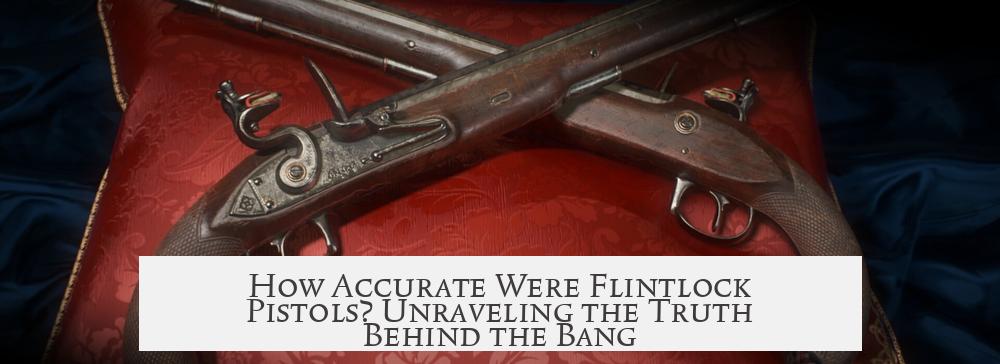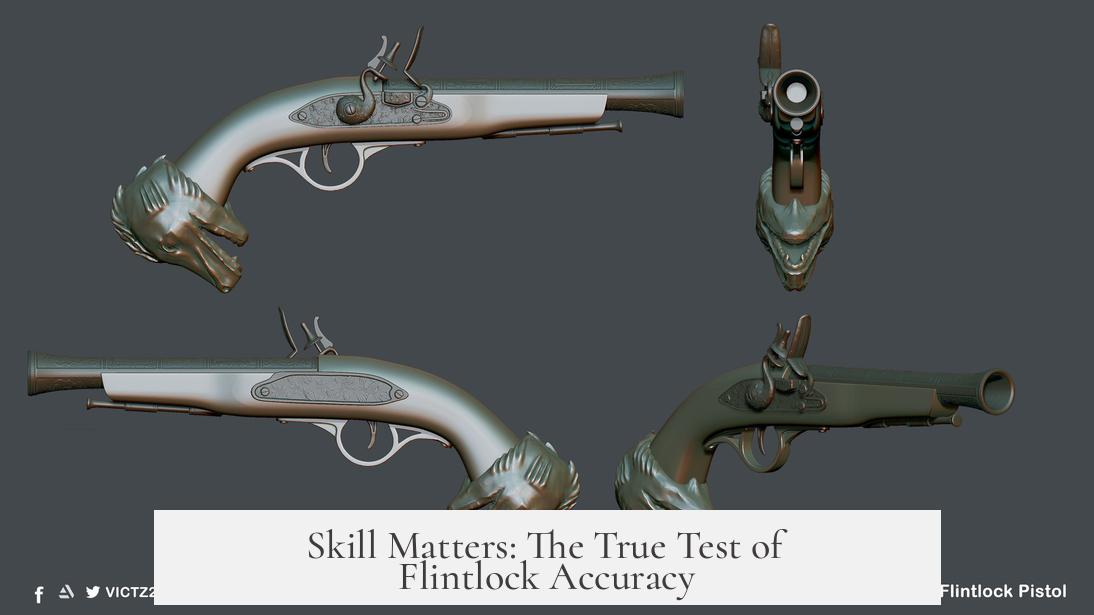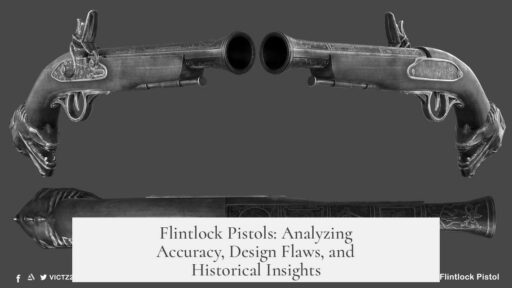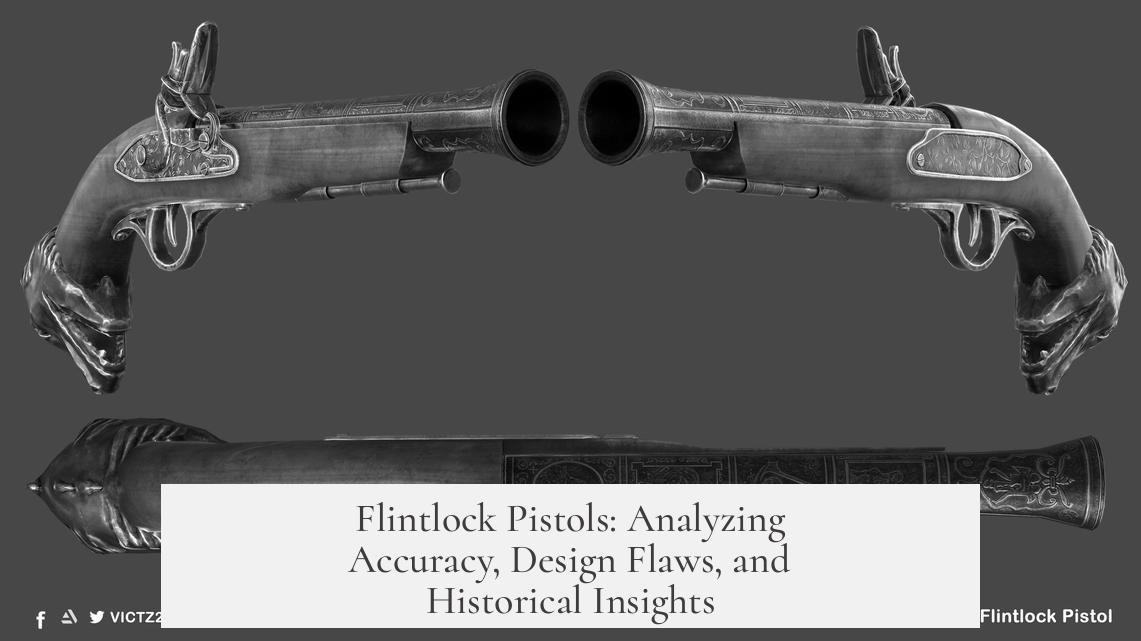Flintlock pistols were generally inaccurate weapons, especially compared to modern firearms. Their design, ammunition, and the properties of black powder limited their precision. While skillful users could improve results somewhat, inherent flaws kept accuracy low.
One major factor affecting accuracy was the weapon’s construction. Flintlock pistols used smoothbore barrels, unlike rifled barrels that impart spin to bullets and improve stability. These smoothbore barrels created more spread in shots. Also, pistols had shorter barrels than muskets. This length deficit reduced the ability to stabilize the ball during firing, further harming accuracy.
Black powder’s power varied significantly. Shot force depended on the amount and purity of powder loaded. Lower purity often produced weak shots. Underpowered shots sometimes barely wounded targets. This powder inconsistency made consistent aiming difficult, especially at greater distances.
The space between the barrel and the ball, called windage, was another accuracy issue. Significant gaps allowed gases to escape unevenly around the ball, reducing velocity and causing erratic trajectories.
Interestingly, dueling pistols were even less accurate by design. These pistols aimed to minimize skill differences among duelists. They used smooth bores, lacked sights, and kept flintlocks instead of switching to more reliable caplocks. Flintlocks misfired about once every six shots while caplocks failed much less often. The idea was to introduce an element of chance, not precision.
Mastering flintlock pistols demanded great practice and skill. Early 19th-century gentlemen sometimes honed their skills at shooting galleries, performing feats like snuffing candle wicks without damaging the wax. Such precise shots showcased expertise but remained exceptions rather than common outcomes.
| Factor | Impact on Accuracy |
|---|---|
| Smoothbore Barrel | Increases shot spread, reduces precision |
| Short Barrel Length | Less stabilization, lower accuracy |
| Black Powder Quality | Variable power causing inconsistent results |
| Windage | Gas leakage causing erratic ball flight |
| Dueling Pistol Design | Deliberately made inaccurate to hinder skill |
| Required Skill Level | High skill needed for better accuracy |
- Flintlock pistols’ accuracy suffers due to smoothbores and barrel length.
- Black powder quality and windage contribute to inconsistency.
- Dueling pistols were designed to reduce accuracy on purpose.
- Skilled shooters could perform precise shots but had to practice extensively.
How Accurate Were Flintlock Pistols? Unraveling the Truth Behind the Bang

Are flintlock pistols accurate? The short answer is a blunt YES — but that yes comes with a massive, smoke-filled “not really.” These charming old relics from the age of muskets and powdered wigs might look sleek and deadly in movies, but their real-world precision leaves a lot to be desired. Let’s unpack this dusty history with some facts, figures, and a splash of smoky humor.
Picture an 18th-century gentleman, dressed to the nines, aiming a flintlock pistol with a poker face. Would he pierce his target with the precision of a modern marksman? Probably not. These pistols were notoriously quirky, backed by the era’s technology, black powder’s fickle nature, and design “choices” that didn’t scream accuracy.
The Quirks of Flintlock Pistols: Why Were They So Inaccurate?
First, imagine a pistol barrel that’s a few millimeters wider than the lead ball it fires — this gap is known as windage.
It’s like trying to shoot a marble through a garden hose — the marble doesn’t fit snugly, so it rattles around, losing energy and precision. This gap was essential; it allowed the ball and powder to fit, but it made the shot inherently unstable. The result? The ball could veer off the desired trajectory quite easily.
Now, pistols had an extra challenge. Unlike longer muskets, pistols didn’t have the barrel length to “straighten out” the ball’s spin and direction. The musket’s longer barrel gave the ball time to stabilize, increasing accuracy. Pistols? Short barrels, short accuracy span.
And that black powder? Don’t even get me started. It’s about as powerful as a wet sparkler on a damp night, quite unpredictable. How much power did the shot pack? Depending on the powder’s purity and the load, it could be a deadly bullet or just a painful bruise. In fact, poorly made shots were so common that the pistol might leave a questionable mark rather than a fatal hole.
Dueling Pistols: Designed to Miss, Sort Of
Here’s a twist: some flintlock pistols, especially those used in duels, were deliberately made less accurate. Weird, right? According to historical sources like The Art and History of Personal Combat, dueling pistols were designed with handicaps.
- Smooth bores instead of rifled barrels (which would have improved accuracy).
- No sights — so no aiming aid.
- Sticking stubbornly to the outdated flintlock mechanism even after the better caplock appeared.
Why? To level the playing field and remove the edge of skill — making duels less about who’s the best shot and more about honor and chance. Flintlocks even had a quirk where they misfire about one time in six. Caplocks were more reliable, failing only once in a hundred shots, but flintlocks had the drama and unpredictability needed for a tense duel.
Skill Matters: The True Test of Flintlock Accuracy

Despite all these limitations, some people were downright impressive with flintlock pistols. Mastering them wasn’t child’s play. It demanded serious talent and a heap of practice.
If you stroll through history’s corridors, you find that early 1800s London gentlemen often visited places like Manton’s for target practice. It was a mix of training and social fun. The magic trick? Skilled shooters could extinguish candle flames — not by blowing, but by shooting the wick alone, without melting the wax below. That kind of precision was like firing a bullet through a needle’s eye.
So, while flintlocks were broadly unreliable, seasoned users turned them into effective weapons.
What Does This Mean for Modern Understanding?
If you’re thinking about how flintlocks stack up against modern guns, here’s the punch line:
- Flintlock pistols were inherently inaccurate due to design flaws and primitive tech.
- Dueling pistols purposely traded accuracy for drama and fairness.
- Skill and diligent practice could overcome some of these hurdles, turning a flintlock into a surprisingly precise tool under the right hands.
But asking “How accurate were flintlock pistols?” is like asking, “How reliably does a weather vane predict the wind on a stormy day?” They weren’t made for pinpoint hits, but for close encounters, shock, and the flair of the moment.
Practical Tips and Historical Insights
For enthusiasts or reenactors curious about flintlock performance, here’s some guidance:
- Don’t expect sniper precision. Set your sights (or lack thereof) accordingly.
- Practice is everything. Even back then, skill changed outcomes dramatically.
- Understand powder quality. It directly affects power and consistency.
- Appreciate the role of windage. Know your pistol’s ball fit; tighter is better but must still allow loading.
- Consider pistol type. Duel pistols were fun and fair but less deadly than battle pistols.
For those who love history or want to shoot historical firearms, remember: flintlock pistols tell a story of technology’s infancy, human skill, and the theatrics of honor.
Final Bang: The Flintlock Pistol’s Place in History
Flintlock pistols shine less for sharpshooting and more as cultural icons. They symbolize an era when firearms were as much about ceremony — duels, self-defense in gentlemanly fashion — as about muscle and metal. Their “accuracy” lies not in the shot’s path but in the hands that wielded them and the stories whispered after the smoke cleared.
So next time you see a flintlock pistol, remember: it’s less a tool of precision and more a relic of style, skill, and the unpredictable dance of gunpowder and steel.




